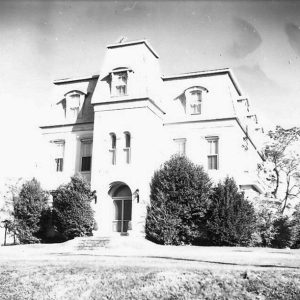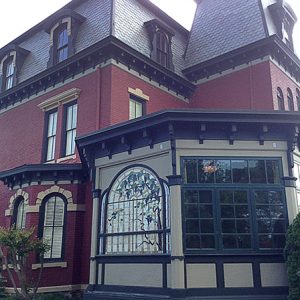calsfoundation@cals.org
McDonald-Wait-Newton House
aka: Packet House
aka: 1836 Club
The McDonald-Wait-Newton House, also commonly referred to as the Packet House, is located in Little Rock (Pulaski County). The nineteenth-century house is a good example of the Second Empire architectural style and was listed on the National Register of Historic Places due primarily to its architectural significance.
When the Packet House was constructed, its address was 1406 Lincoln Avenue; the road name was later changed to Cantrell. The people who built in the area had some association to the North; either they supported the North during the Civil War, or they moved south during Reconstruction, leading to the nickname of “Carpetbagger’s Row” for the homes along the road. According to the National Register of Historic Places nomination form, “The Packet House is the oldest of the five brick homes built shortly after the Civil War on the north side of Lincoln Avenue and is the only remaining structure of the original ‘Carpetbagger’s Row’ Mansions.”
Alexander McDonald constructed the house in 1869. McDonald moved to Arkansas shortly after Union soldiers captured Little Rock in 1863. He was president of Merchant’s National Bank and was also involved in railroads. McDonald was a Republican U.S. senator from Arkansas from 1868 to 1871. For a time, he was believed to be the richest man in Arkansas. He had the house built while he was senator. McDonald wanted to be reelected by the Arkansas General Assembly but was not chosen again. Shortly after his political defeat, he sold the house and moved to New York.
William B. Wait bought the house. He had moved to Arkansas Post (Arkansas County) from Knoxville, Tennessee, in 1830. Eventually, he made his way to Little Rock. Wait was involved in the merchandising business and later had dealings in real estate. He was also president of Merchant’s National Bank for a time.
In 1887, Ann McHenry Reider purchased the house, and her two daughters and their families moved in. Both daughters had married into the prominent Newton family. One daughter, Amanda Reider, married Thomas Newton, and the other daughter was married to his brother, Robert. The house remained the Newton family home for four generations. It was sold around 1946 and converted into apartments, being renamed the Packet House because it overlooked the Arkansas River, which was once filled with packet boats.
At the time of its construction, the Packet House was considered to be on the outskirts of the city, but it is now in one of the busiest central areas. The Packet House’s main significance is its architecture. The Packet House is a two-and-a-half-story brick house that is one of the few examples of the Second Empire style of architecture popular in the late 1800s. General characteristics of Second Empire–style architecture include a mansard roof, dormer windows, and decorative brackets below eaves; generally, the building is square or rectangular, while the roof has colored tilework, and such structures may have towers. As an example of the Second Empire Style, the Packet House reflects several of these characteristics. The home is rectangular, and it has a mansard roof. (A mansard style of roof has two slopes on all sides, with the lower slope steeper than the upper slope.) The mansard roof on the Packet House has twelve dormers; each dormer has a window. The house also has a number of decorative windows. The transom above the front double doors is a decorative semi-circular window. The windows in the door are also decorative. Noticeable features of the house are the hoodmolds above the windows and the decorative eave brackets.
The McDonald-Wait-Newton House (Packet House) was added to the National Register of Historic Places on June 14, 1978. The Packet House was used for various purposes over the years, including as office space and as several different restaurants. In 2016, the McDonald-Wait-Newton House became the location of the private business club called the 1836 Club.
For additional information:
The 1836 Club. http://www.the1836club.com/ (accessed November 9, 2017).
“McDonald-Wait-Newton House.” National Register of Historic Places nomination form. On file at Arkansas Historic Preservation Program, Little Rock, Arkansas. Online at http://www.arkansaspreservation.com/National-Register-Listings/PDF/PU3243.nr.pdf (accessed November 9, 2017).
Nicole Boer
Camden, Arkansas
 Civil War through Reconstruction, 1861 through 1874
Civil War through Reconstruction, 1861 through 1874 Historic Preservation
Historic Preservation McDonald-Wait-Newton House (a.k.a. Packet House)
McDonald-Wait-Newton House (a.k.a. Packet House)  Missouri Pacific Hospital
Missouri Pacific Hospital  Packet House
Packet House  Packet House Rear
Packet House Rear 




Comments
No comments on this entry yet.